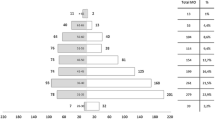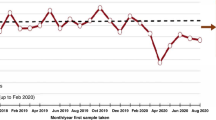Abstract
The advent of individualized medicine with novel guidelines, extended quality assessment as well as intensified conventional, immunohistochemical, and molecular characterization of diseases has led to a substantial increase of pathologists’ workload. Furthermore, in industrialized countries, we are facing the challenges of demographic change with an aging population. This raises the question of how pathology will be affected by these developments in the future. We extracted German population data and data on the number of board-certified physicians and pathologists from official sources. These data were reviewed in the light of data on caseload, case complexity, auxiliary diagnostic procedures, and matching patient data from a large German pathology department serving as a sector independent regional service provider. The refinement of diagnostic procedures over the last decade has resulted in a 60 % increase in slide numbers per case, doubling of immunohistochemistry procedures, and more than tripling of molecular analyses. Correlation of this development to demographics suggests that an aging population will further increase the caseload and case complexity in the coming decades since patient age is tightly linked to both parameters. This development is currently not accompanied by a sufficient increase in the number of pathologists. Our data point toward an imbalance between the increase in pathology workload and the number of pathologists. Extrapolations suggest a further aggravation of this development in the future. Thus, healthcare systems need to address this problem urgently in order to cope with these challenges.






Similar content being viewed by others
References
Warth A (2009) Demografischer Wandel und die Gesundheit für Generationen: Eine Auseinandersetzung zu den bevorstehenden Zukunftsaufgaben im Gesundheitswesen. Grin, Munich
Halaweish I, Alam HB (2015) Changing demographics of the American population. The Surgical Clinics of North America 95(1):1–10. doi:10.1016/j.suc.2014.09.002
Peters E, Pritzkuleit R, Beske F, Katalinic A (2010) [Demographic change and disease rates: a projection until 2050]. Bundesgesundheitsblatt, Gesundheitsforschung, Gesundheitsschutz 53(5):417–426. doi:10.1007/s00103-010-1050-y
Biermann J, Neumann A, Hewer A, Wasem J, Erbel R, Neumann T (2010) Influence of the demographic change on hospital admissions and costs in Germany. Med Klin (Munich) 105(12):876–881. doi:10.1007/s00063-010-1152-1
Pritzkuleit R, Beske F, Katalinic A (2010) Demographic change and cancer. Onkologie 33(Suppl 7):19–24. doi:10.1159/000319738
Wild S, Roglic G, Green A, Sicree R, King H (2004) Global prevalence of diabetes: estimates for the year 2000 and projections for 2030. Diabetes Care 27(5):1047–1053
Winter S, Cox GJ, Corbridge R, Chaplin AJ, Millard PR, Shah KA (2004) Effects of clinical service reorganisation on cellular pathology workload. J Clin Pathol 57(1):22–26
Wer sind wir und wenn ja, wie viele? (2012). Patho. (1):4–7
Colgan TJ, Geldenhuys L (2012) The practice of pathology in Canada: decreasing pathologist supply and uncertain outcomes. Archives of Pathology & Laboratory Medicine 136(1):90–94. doi:10.5858/arpa.2011-0188-OA
Meijer GA, Oudejans JJ, Koevoets JJ, Meijer CJ (2009) Activity-based differentiation of pathologists’ workload in surgical pathology. Virchows Arch 454(6):623–628. doi:10.1007/s00428-009-0768-0
Warth A, Endris V, Kriegsmann M, Stenzinger A, Penzel R, Pfarr N, Weichert W (2015) Molecular diagnostics of non-small cell lung cancer: new markers and technologies. Pathologe 36(2):154–163. doi:10.1007/s00292-015-0004-4
Warth A, Endris V, Penzel R, Weichert W (2014) Molecular pathology of lung cancer. State of the art 2014. Pathologe 35(6):565–573. doi:10.1007/s00292-014-1918-y
Endris V, Penzel R, Warth A, Muckenhuber A, Schirmacher P, Stenzinger A, Weichert W (2013) Molecular diagnostic profiling of lung cancer specimens with a semiconductor-based massive parallel sequencing approach: feasibility, costs, and performance compared with conventional sequencing. J Mol Diagn 15(6):765–775. doi:10.1016/j.jmoldx.2013.06.002
Trotter MJ, Larsen ET, Tait N, Wright Jr JR (2009) Time study of clinical and nonclinical workload in pathology and laboratory medicine. Am J Clin Pathol 131(6):759–767. doi:10.1309/AJCP8SKO6BUJQXHD
Acknowledgments
We gratefully acknowledge Uschi Horr (Institute of Pathology, Heidelberg) for technical assistance.
Author information
Authors and Affiliations
Corresponding author
Ethics declarations
Conflict of interest
The authors declare that they have no competing interests.
Rights and permissions
About this article
Cite this article
Warth, A., Stenzinger, A., Andrulis, M. et al. Individualized medicine and demographic change as determining workload factors in pathology: quo vadis?. Virchows Arch 468, 101–108 (2016). https://doi.org/10.1007/s00428-015-1869-6
Received:
Revised:
Accepted:
Published:
Issue Date:
DOI: https://doi.org/10.1007/s00428-015-1869-6




